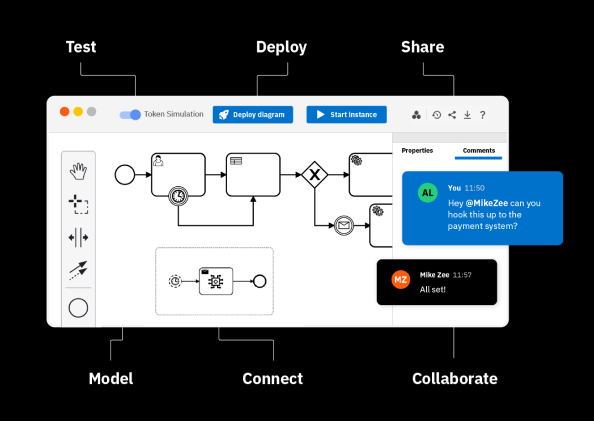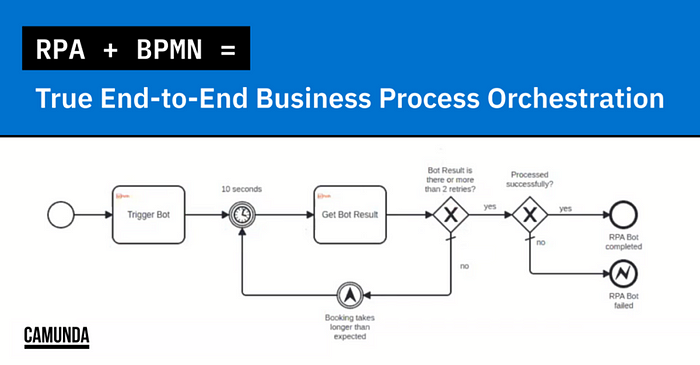Tackling Remote Employee Onboarding Hurdles with Camunda and EasyRPA

Author: Alexei Bolotin
According to 2023 onboarding statistics, organizations with strong onboarding processes increase new hire retention by 82% and improve the productivity by 70%.
Such an increase can greatly boost a company’s profits and work environment harmony. Effective onboarding programs seamlessly integrate new hires and tap into their potential as key contributors, providing a competitive advantage and contributing to substantial growth, employee contentment, and business success. The need for this approach is particularly more obvious in the post-COVID-19 era, where remote work has increased and remote onboarding has become a thing in the modern business landscape.
Now why is this so?
Well, we like to believe that workflow automation has changed the employee onboarding space and has the potential to increase employee retention and company revenue.
But using any type of RPA tool or platform won’t cut it.
That is why this article will describe how we have been able to revolutionize employee onboarding using cutting-edge technologies like EasyRPA and Camunda automation.
We will also describe one of our case studies to show how we deployed these technologies.
So, if you are looking to optimize your employee onboarding process, then you might want to…
Keep reading.
How Camunda and EasyRPA Work
Before getting into how we combined both technologies, let’s take some time to describe them.
What is Camunda?

Camunda, named from Latin verbs meaning ‘comprehend’ and ‘clean’, is a versatile process automation platform that operates both as an independent process engine server and as an integration within Java applications.
Camunda is popular among developers because it boasts a Workflow Engine that implements processes that are defined in the Business Process Model and Notation (BPMN). Camunda’s BPM allows businesses to easily automate their most complex workflows.
The Camunda engine also offers non-Java developers a REST API and client libraries that can be used to build applications that connect to a remote workflow engine.
The Camunda platform performs the following tasks:
- Automating business processes from end to end
- Orchestrating processes across diverse endpoints
- Control of RPA bots
- Building of automated decisions into business processes
- Advanced process execution
- Integration with technology stacks all thanks to its Camunda connectors
You can assess the platform’s capabilities by using the free Camunda Modeler BPMN 2.0. This tool enables editing of BPMN Process Diagrams, DMN Decision Tables, and forms, providing a hands-on experience with Camunda’s functionalities.
What is EasyRPA
Developed by IBA Group, EasyRPA is a modern RPA platform offering comprehensive automation for various applications, including Java, Oracle, and SAP, with ease of use for developers. It is a flexible, state-of-the-art, service-first RPA platform that simplifies automation across processes. It is a cost-effective means of developing, deploying, running, and monitoring software robots used in business processes. The unique thing about the EasyRPA platform is that, unlike most RPA tools, it was built with developers in mind. That way, developers across industries can seamlessly deploy this tool in automating business processes with little or no integration.
It also boasts end-to-end, AI-driven process automation and a built-in OCR engine that supports integration with ABBYY FlexiCapture software.
EasyRPA is great at automating:
- Java and Oracle Forms applications
- Web-based applications
- Desktop applications (including the remote desktop applications)
- SAP applications
- Just about any application written to run in terminals or mainframes
What the Camunda and EasyRPA collaboration offers

The collaboration of Camunda BPM solutions and EasyRPA offers tons of benefits to companies using Camunda. Both platforms complement each other and so can be deployed in a manner that enables businesses to achieve maximum business process automation.
How so?
BPMN Camunda can be used to handle a range of end-to-end business activities while EasyRPA automates smaller, repetitive tasks using bots that can easily be controlled using Camunda workflow automation.
The idea is to use EasyRPA to handle rote, “bot-specific” tasks. Thanks to the nature of Camunda software development, businesses can then deploy Camunda to handle those more complex tasks that RPA technologies traditionally struggle with i.e. complex, long-running processes that often involve a variety of different endpoints.
When these tools are properly combined by the right Camunda service, here are some of the available benefits:
- Increased automation of processes
- Increased efficiency of RPA tasks since they can be monitored and certain process instances edited in real-time. Stakeholders can also ascertain the RPA tools’ performance to identify issues that might affect end-user experience.
- Optimized ROI on RPA tool investment
- Collaborations between robot owners and process owners are enhanced since workflows that involve EasyRPA can be modeled like BPMN-based processes
- Interactions between processes, bots, and humans become more efficient.
Now that you have a good grasp of how the EasyRPA and Camunda platforms work, let’s take a look at one of the cases where we implemented Camunda BPM Solutions to meet a customer’s needs.
Camunda and EasyRPA Case Study
The customer
One of our customers needed help with optimizing their employee onboarding process. The customer in question was a large IT company based in Europe.
Our team comprised of 6 members:
- Delivery manager
- Camunda expert / consultant
- Business analyst
- Camunda/Java lead developer
- AI-developer
- Data analyst
The period for the development and implementation of the project was 4 months.
The challenge
The customer’s problem was created by difficulties in implementing business processes that required the physical presence of employees during the COVID-19 pandemic.
The customer needed help in quickly resolving business process issues that were subject to the personal presence of employees such as onboarding.
They realized that to stay competitive in their industry, they would have to rethink and transform their business processes.
The Camunda platform was adjudged to be the best technology to tackle the challenge. Camunda’s spring boot feature facilitated seamless integration, while the Camunda tasklist simplified the management of human tasks of all operators involved in the process.
Due to their position as leading Camunda support providers, IBA Group was engaged to help them implement the needed changes to their business processes.
Our Camunda service was challenged to create custom solutions that offered the customers the flexibility, speed, and efficiency they needed without going against compliance standards.
Goals and tasks of the project
Automating employee onboarding processes provides a ton of benefits to modern businesses. However, this has to be done in line with best practices.
As such, the goals and tasks of IBA Group in this project were clearly defined. The focus was on developing and implementing an automated employee onboarding process that minimized the time required for the process.
IBA Group action plan for the project
Employee onboarding automation requires careful planning and preparation because the stakeholders involved must outline the specific onboarding activities that require automation, assess the resources needed for execution, and develop a project timeframe.
Based on this line of approach, IBA Group’s action plan for the project demonstrated a comprehensive approach to addressing the challenge of employee onboarding during the COVID-19 pandemic:
Here are the key points of the team’s action plan:
1. An analysis of the current business process: The project began with a comprehensive analysis of the existing onboarding process. This was an essential step because it facilitated the understanding of the areas where automation can be introduced and how to improve efficiency.
2. The identification of potential automation stages: This stage involved identifying the stages that were to be automated. This helped focus efforts on the most critical components of the process.
3. An analysis of the problem of inability for in-person candidate/HR interaction: This analysis helped IBA Group team understand the significant limitations imposed by the pandemic and how they affected the onboarding process.
4. Selection of technical solutions: This involved choosing a technical solution that would streamline onboarding workflows. The decision was made to implement the Camunda platform.
As for automating tasks that were previously done manually, the choice was made to employ robotic process automation using EasyRPA. AI technology was also utilized for document classification and recognition.
5. Designing the new business process: Creating a new business process based on the Camunda platform allowed for the coordinated management of all stages and steps.
6. Automation using EasyRPA: Implementing robots significantly enhanced the efficiency and speed of request processing. This was achieved by the automatic creation of employee profiles, and the generation of the necessary documents and requests during employee onboarding.
7. Integration with the Customer’s HR System: The Integration with the customer’s HR system served to reduce the risk of errors and ensured data accuracy.
8. Tasks for HR personnel and employees: The automated creation of tasks for HR personnel guaranteed control and necessary human actions when required.
9. Notifications: Notifications about successful stages and issues would maintain awareness among all the stakeholders involved.
Results of the project
Here are the results of our project on employee onboarding automation.
1. Reduced Onboarding Time: Reducing the onboarding process from several days to 4 hours represented a significant improvement. This not only saved the company time, it also made the process more convenient and enjoyable for new employees.
2. Enhanced Company Reputation: The rapid adaptation to new conditions and improved workflow helped strengthen the company’s reputation as a place that cares for its employees and responds to changes in the modern business landscape.
3. Increased Employee Net Promoter Score (eNPS): An 8% increase in the employee Net Promoter Score indicates that the HR department employees positively assessed the changes and felt more satisfied and content with their work.
4. Efficient Document Recognition: An 85% correct document recognition and classification rate demonstrates that the AI system is successfully performing its tasks, reducing the risk of errors and increasing process efficiency.
5. Reduced Document Reruns: A 67% reduction in document reruns due to data errors reflects higher process accuracy and reliability. Consequently, the reduced document reruns save time and resources.
These results confirm that the automation of the customer’s employee onboarding process was effective and successful. The success of the project would contribute to the company’s competitiveness and employee satisfaction.
Conclusion and recommendations
Based on the results of the project, here are some recommendations that we have for you:
1. Flexibility and Speed: Flexibility and rapid response to external changes are becoming increasingly important in the modern business space. Companies should be prepared for quick adaptation and constant improvement of their processes.
Thankfully, Camunda users can combine the software with EasyRPA to be able to immediately and conveniently plug any lapses in their business processes.
2. Automation and RPA: Utilizing modern technologies such as Camunda and robotic process automation (RPA) helps reduce time and resources, improve service quality, and decrease the likelihood of errors.
3. Integration with New Technologies: It is imperative to stay abreast of the latest technological trends and innovations. Informed investments in modern tools and systems can significantly enhance your competitiveness and keep you ahead of your peers.
4. Employee Training: It’s essential to train your staff on how to use new technologies and tools. You must provide access to training and skill development so that your employees can confidently integrate innovations into your business processes.
5. Monitor Feedback: You should actively collect and analyze feedback from customers, employees, and other stakeholders to identify issues and needs, enabling improvements and enhancements to business processes.
6. Goal — Improve Experience: The primary goal of any changes in business processes is to improve the experience of your customers and employees. As such, every change that you implement should be aimed at increasing satisfaction (client/employee) and improving results.
Companies that can follow these recommendations will effectively address most of the challenges that arise in the course of their business operations. Such companies would also become more competitive, efficient, and easily adaptable to the rapidly changing modern business environment.